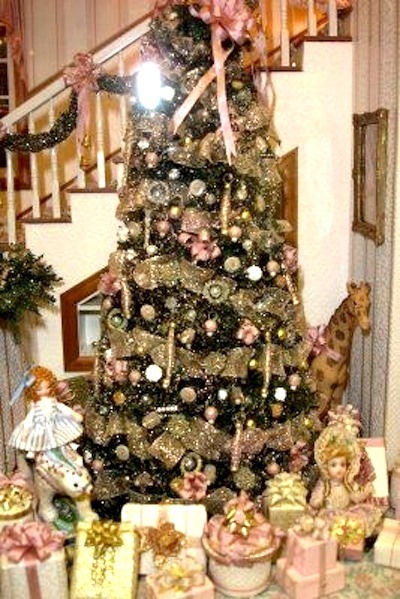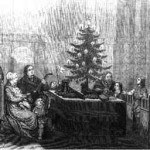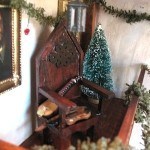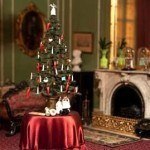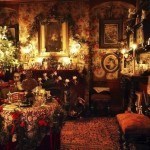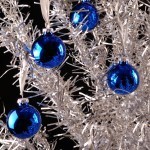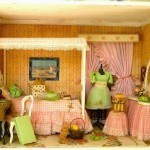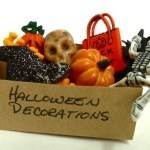Christmas Tree Timeline
The Christmas tree has been a German tradition since the 17th century. But many ancient civilizations decorated evergreen trees and plants as a symbol of eternal life, deriving comfort from this symbol of eternal life during the long winter months. I hope this timeline helps when decorating your miniature for the Holidays.
Ancient Rome
Holly was an important part of the Roman solstice ceremony known as “Saturnalia.” It was believed that the red berries would ward off lightning and evil spirits. However, it had to be carried into the house by a male, as the berries are only on the male plant. Ivy was twined in the holly as a symbol of the 2 halves of divinity.
Druid priests harvested another evergreen, mistletoe, from sacred oak trees on the fifth day after the new moon following the winter solstice. Norse warriors met under the mistletoe to declare a truce for the day.
Mistletoe was not allowed in Christian churches because of its pagan origins.
There is no “one-true” English or American Christmas tree, no matter the era of your miniature project There are so many variables that research is critical if you are recreating a room box or dollhouse from a specific time or place.
As dollhouse miniatures are grouped by era, it may be helpful to present this Christmas Tree timeline the same way.
Late Medieval
1510 – First recorded decorated Christmas tree in Latvia.
1536 – The story goes that Martin Luther “invented” the Christmas tree on a cold December night. Luther walked through a pine forest near his home in Wittenberg and saw thousands of stars glinting jewel-like among the branches of the trees. He set up a candle-lit fir tree in his house to teach his children that the starry heavens brought them closer to God. By the mid-1600s, decorated Christmas trees, Tannenbaums, appeared across Southern Germany.
Tudor
There would be no Christmas tree In England for tw0-hundred years or so. However, they did have the Yule Log, which would be brought into the home on Christmas Eve, decorated with ribbons and then lit and kept burning through the 12 days of Christmas. People thought it was lucky to keep some charred remains to light next year’s log.
1610 – Tinsel is invented in Nuremberg, Germany
Throughout the seventeenth century, Christmas street-markets in Germany would be centered around a tall conifer decorated with flowers, wax ornaments, presents, shaped gingerbreads and other foods. The early trees were symbolic of the Paradise Tree in the Garden of Eden. The many food items were symbols of plenty. The only flowers were red, for knowledge and white for innocence.
The first German immigrates in the United States came to Jamestown in 1683 and where ever Germans settled, the Tannenbaum flourished. Small trees were set up on a side table in the home. As German communities grew, street markets with a large tree appeared, just like
in the old country. Still, popularity stayed within the German neighborhoods. Yankees considered the tree garish. To Puritans, it was a sign of the devil.
Georgian
1800 – Good Queen Charlotte, the German wife of George III, created a sensation when she set up the first known English Christmas tree at Queen’s Lodge, Windsor, in December 1800. Assisted by her ladies-in-waiting, the queen herself dressed the boughs. She thought it would make an enchanting spectacle for the children.
It certainly did. When they saw that magical tree, with wax tapers burning and colored ornaments reflecting the light, the children believed they had been transported straight to a fairyland. The whole Court gathered round and sang carols. The festivity ended with a distribution of gifts from the tree branches, which included clothes, jewels, plates, toys, and sweets.
By the time Queen Charlotte died in 1818, the Christmas-tree tradition had trickled down from the Royals and Honorables to the merchant class.
Victorian
1846 – The Victoria and Albert Tree
An engraving of the Royal Family standing in front of a single large tree at Windsor was published in the Illustrated London News. Victoria was loved by her subjects and the English Christmas Tree was on its way, helped in no small part by some good press coverage.
Decorations were still home-made. Young ladies spent hours at Christmas Crafts, quilling snowflakes and stars, sewing little pouches for secret gifts and paper baskets filled with sugared almonds. They also had bead decorations and finely drawn silver tinsel, the trees topped with beautiful angels. Candles were often placed in wooden hoops for safety.
Live trees were decorated with lighted candles, draped with tinsel, ribbon, paper chains, cookies, and candies.
1850 – The Mid-Victorian Tree. Homemade ornaments began to be replaced when a German manufacturer produced fancy glass ornaments and bead garlands. Another manufacturer exported a big hit, the Rauschgoldengel – a tingling angel. It was dressed in gidted tin, which acted like a bell and clanged away in the rising heat of the candles.
1860 – Most well-off families had a Christmas tree in the parlor or hall. The parties held for pauper children featured gift-laden Christmas trees as their main attraction. The spruce or fir tree branches were no longer cut into artificial tiers or layers as in Germany but allowed to remain as nature had intended, with candles and ornaments arranged randomly.
1870 - Glass ornaments were now the most popular tree decoration in England. As the British Empire spread around the world, a popular tree-topper became the nation’s flag, as well as flags of conquered countries. The Christmas tree became patriotic.
1880 – Festivities for early Victorians centered around family, food and homemade gifts. Only the wealthy could afford store-bought items. But in the 1880s, New York merchants saw the advantages of a holiday that featured the exchange of gifts and Christmas went commercial. Macy’s department store windows were filled with wonderful dolls and toys from Germany, France, Austria, and Switzerland.
Paper cornucopias with fruit, nuts, candy, and popcorn were hung from branches of Christmas trees in America and England. Beautifully shaped cookies were hung for treats. Often the gifts were wrapped and hung from branches.
With the growing popularity of Christmas trees, manufacturers began producing ornaments. Also popular were molded wax figures of angels and children. Many ornaments were made of cotton-wool wrapped around an armature of metal or wood and trimmed with embossed paper faces, buttons, gold paper wings and “diamond dust”, actually powdered glass.
FW Woolworth imported manufactured ornaments to America. The Christmas trees became a glorious hotchpotch of everything one could cram on. This excess brought on a counter-movement, the Aesthetic Tree It was delicately balanced, with soft colors, shapes, and style. Both types came in tabletop or floor standing models, whatever one could afford.
1882 – A patent was granted in the U.S. for strings of colored electric lights.
1884 – The High Victorian Tree This was a child’s joy to behold! Rising to the ceiling and crammed with glitter and tinsel and toys galore. Even the ‘middle classes’ managed to over-decorate their trees. It was a case of ‘anything goes’.
1892 – A U.S. patent was granted for curved hooks that safely hung decorations from trees branches.
1900 – Themed trees were popular. Mono-color, Oriental or Egyptian Tree. Unfettered imagination.
1903 – Queen Victoria dies So did Victorian Christmas tree. It was considered “bad form” for a country in mourning t0 indulge in such excess. Not until the 1930s nostalgia for Dickens ian fashion did the High Victorian Tree make a come-back.
And the Victorians brought back mistletoe as a Christmas decoration – but with a twist. Those who met under mistletoe could claim a kiss. With each kiss given, a berry was plucked, until there were no more berries … and no more kisses!
Edwardian
The twentieth century saw the return of the Goose Feather Tree. It was invented by German environmentalists in the 1880’s to combat damage to the forests in the name of Christmas.
The Addis Brush Company gave us the brush trees, using the same machinery which made their toilet brushes.
The UK gave us the ‘Silver Pine’ tree, with a revolving colored-light source at its base that shown upwards though shimmering branches. No decorations necessary. The U.S. struck back with the Silver Aluminum tree, which just stood there, either unadorned or laden with colorful ornaments.
Contemporary & Modern
There has been so much mixing and matching since the end of the Edwardian era that it seems unnecessary to go into the possibilities here. For kicks, we borrowed an Aluminum tree a few years ago from a neighbor. It had been in her attic since the turn of the century … the 20th century. It was nice for a one-time change. Other than the Art Deco period, there are few rules, and those are pretty loose.
Have fun decorating your dollhouse miniature for the holidays!!
Susan Downing, with Patrick Owens
_________________________________________________________________________
I invite you to visit my Etsy Shop where I offer many accessories and pieces of furniture in 1:12 scale.


